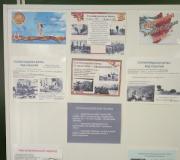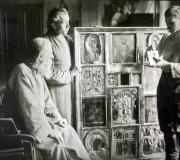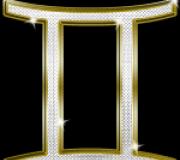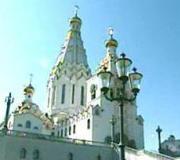Interpretation of Roerich's painting heavenly battle decoding. Russian artist Nikolai Konstantinovich Roerich
07.09.2016
Description of the painting by Nicholas Roerich “ Heavenly fight»
As you know, Nicholas Roerich often depicted clouds in his paintings. But in this picture they represent the basis of the plot, as if passing through their heavenly essence all the struggle that fills our world. The picture is a kind of cloudy pattern, satiated with a riot of movement and colors. The clouds depicted at the top of the picture are white, and flowing water can be seen through them. sunlight. The lower the clouds, the richer and darker they become - from yellow to dark purple, with shades of brown. It seems that below, above the ground, thunderclouds have gathered, ready to pour down with heavy rain. But even in this form they are fascinating.
In the picture the whole sky is covered in clouds. If you look at them for a long time and carefully, you can see all the violence and mercilessness of the elements, and at the same time admire their perfection and some special beauty that is not inherent in earthly things. And at the same time, looking at the picture, you understand that these clouds are something close, you want to take them in your hands, becoming familiar with lofty matters. The clouds evoke various earthly images - they either look like wild, unprecedented animals, or like brave horsemen, or like a grandiose naval squadron, whose ships set out on a long and difficult voyage... However, in addition to this cloudy triumph, the earth is also represented in the picture. But here its significance is secondary, as evidenced by the fact that earthly objects have taken on the color of clouds - mountains, houses, a pond. They seemed to be influenced by what was happening in the heavens. What is this picture about? What was the cause of the confrontation that resulted in a heavenly battle? The viewer is free to decide for himself. But despite this, we can consider that the artist depicted the struggle of two principles, two poles of our world - the battle of good and evil, light and dark, progressive and conservative.
SKY BATTLE In all Roerich's paintings, the sky and clouds occupy a special place, full of deep symbolism. In the article “Celestial Architecture” he writes: “From early years celestial architecture provided one of the greatest joys. Among my first childhood memories are beautiful patterned clouds. Eternal movement, generous rearrangement, powerful creativity ties the eyes upward for a long time. Wonderful animals, heroes fighting dragons, white horses with wavy manes, boats with colored gilded sails, tempting ghostly mountains - what was missing in these endlessly rich, inexhaustible pictures of the heavens... Paintings "Heavenly Battle", "Command of Heaven" and many others are built on cloud formations. The blue of the sky is also beautiful, especially when at heights it has an ultramarine, almost violet purity." Wagner's music always made a huge impression on Roerich. He saw musical works Wagner (especially “Ride of the Valkyrie”) mighty picture, which is endowed with transparency and strength at the same time. In the painting “Heavenly Battle”, less than a fifth of the part is occupied by a valley with lakes and pile buildings. The rest is swirling clouds, then permeated with golden sunlight, then turning into blue thunderclouds. This is the struggle of Light and darkness. The heavenly and the earthly seemed to split into two, as if they moved away from each other. There's a fight going on between two beginnings. There is something hidden in these irregular, warring forms of clouds. At first, the figures of flying Valkyries were painted on a copper-sounding cloud, which the artist then turned into clouds: “Let them be present invisibly”... Even if invisibly, these forces are really present there. The pile village depicted below seems to have fallen silent, awaiting the outcome of the battle of the elements. What could have given rise to such a “heavenly battle?” Of course, only anger, denial, selfishness and others negative qualities people who upset the balance not only in man himself, but in all of nature. Human imbalance causes disorder of the elements and all kinds of natural disasters. And although the dark masses of clouds are still strong, fiery formations are already displacing them. People will have to answer for their offspring.
Nicholas Konstantinovich Roerich is a unique author, whose works are distinguished by deep philosophical and lyrical motifs. The themes of his paintings are varied and complex, spiritual and sublime. Roerich’s favorite images of creativity, in turn, can be considered images of the sky and clouds.
The motif of the sky and clouds sounds clearly in this famous work Roerich as "Heavenly Battle". The painting was painted in 1912, during a difficult time in Russian history. This unusual painting, created on cardboard canvas using mixed tempera techniques, is currently kept in the State Russian Museum in St. Petersburg.
The painting “Heavenly Battle” is filled with more than just artistic images, but with symbols that, first of all, embodied the features and spirit of that era. Most The work is occupied by the image of clouds, which are heavy images that carry an unknown, but becoming more and more visible, threat. Effect tempera painting somewhat reminiscent of a pastel sketch. The painting is characterized by numerous, contrasting transitions of light and shadow. “Heavenly Battle” represents a kind of battle between Light and Darkness, a time when disaster strikes. Roerich's painting demonstrates all the beauty of the complex state of nature. A real confrontation unfolded in the sky. And this heavenly confrontation filled the entire space of the picture plane. The element spread its boundaries far beyond the canvas, which shows the power and grandeur of natural forces. From Roerich’s point of view, even the wrath of the elements is filled with special beauty and cleansing freedom.
Roerich – greatest master transfers states of mind and a different range of feelings and moods. The artist embodies all subtle transitions of states of nature or spirit using the colors necessary from the standpoint of tonality and color. Artistic method Nicholas Konstantinovich Roerich is distinguished by the openness of colorful images, the emotionality of form, the dynamics of lines and colors, symbolism, and the philosophical nature of his works. Roerich's paintings are like succinct prayers or laconic phrases of a sage, in which amazingly combines the desire for the sublime and a simultaneous craving for simplicity and peace.
The pictorial work “Heavenly Battle” reflects the interweaving, “battle” of color and shapes, light and shadow, sky and earth. The technique of antithesis or opposition is clearly implemented here, the technique of global contrast, the eternal confrontation of forces of different sizes. This philosophical phenomenon of “eternal battle” was able to be felt and conveyed by the great genius of Roerich in that troubled twilight time, the time of the beginning of new wars and revolutions. As a true artist, Roerich lived in tact with the life of his Motherland, loved and hated along with it, and even when this Motherland itself turned away from him, he preserved this until the end of his days. great faith creator, this great love to your native land, its history and people. Therefore, the work of Nicholas Roerich still remains so great and valuable to us.
Russian artist Nikolai Konstantinovich Roerich. Series of paintings "Heavenly Battle".S. N. Roerich. Portrait of Academician N.K. Roerich. 1937 (GHML, Riga)
The work of Nicholas Roerich is an exceptional phenomenon in the history of Russian and world art. His canvases are attractive due to the uniqueness of their themes and subjects, their poetry, and deep symbolism. Bright life Roerich is like an amazing legend. Having started his journey in Russia, passing through Europe and America, he ended it in Asia. According to the memoirs of the artist Svyatoslav Nikolaevich Roerich about his father, he was a man “with a clear and thoughtful face. His violet-blue eyes could turn completely dark at times. He always had calm voice, he never raised it, and the whole expression of his face reflected that amazing restraint and self-control that were the basis of his character. It was the calmness of an extraordinary person, serious and friendly, thoughtful, with remarkable keen sense humor. There was a balanced harmony in all his movements. He was never in a hurry, and yet his productivity was amazing. He wrote in a large and clear hand, never correcting or changing his sentences and words, and least of all his thoughts. Under all circumstances, in the most difficult situations, he remained calm and self-possessed and never wavered in his decisions.”
Roerich's artistic heritage is enormous. His paintings, scenery sketches, and drawings are kept in museums and private collections in many countries around the world. In Russia large meetings works of Roerich, except Tretyakov Gallery and the Museum of Oriental Art in Moscow, are located in the State Russian Museum in St. Petersburg, in Nizhny Novgorod art museum and in the Novosibirsk Art Gallery. 
"Heavenly Fight"

"Guga Chohan. Kuluta"

"Holder of the World"

"Mohammed the Prophet"

"Himalaya Watch"

"The city is being built"

"St. Sergius of Radonezh"

"San Giminiano"

"Yaroslavl. Church of St. Blaise"

"Rostov the Great. Church on Ishna" 

"Geser Khan"


"Holy Island"

"City walls of Izborsk (Towers)"

"Guru Guri Dhar"

"Yarilina Valley"

"Saint Nicholas"

"Santana"


"Kuluta. Mountains before dawn" 
"Zmievna, 1906"


"Red Sails. Vladimir's campaign against Korsun, 1900"

"Zvenigorod, 1933"

"Yurts. Mongolia, 1940"

"Lhasa, 1947"

"Old Pskov, 1904"

"Sergius the Builder, 1925"

"The Power of the Caves, 1925"

"Flowers of Timur (Lights of Victory), 1931"

"Smolensk. Porch convent, 1903"

"And we bring light, 1922"
It is difficult to name an artist who changed more often than Roerich. He is one of the few who does not stop on the way. Each new canvas is a surprise both for us and for him. I speak, of course, from a purely picturesque point of view. Not content with knowing a tried and tested technique, he overcomes the temptations of skill and improvises with the refined audacity of a happy seeker. Therefore, the paintings, which so recently seemed to be the result, the conclusion from all previous searches, suddenly acquire a different meaning and are pushed back somewhere. This explains the shortcomings of his works, even the most successful ones. He has more temperament and impatient courage than endurance... The ability to change quickly affects the quality of his work not always in good side. The haste of creativity harms him! Impressionable, receptive - he too easily borrows from others what could be the result of hard and careful work.
Russian artist Nikolai Konstantinovich Roerich. Series of paintings "Heavenly Battle".S. N. Roerich. Portrait of Academician N.K. Roerich. 1937 (GHML, Riga)
The work of Nicholas Roerich is an exceptional phenomenon in the history of Russian and world art. His canvases are attractive due to the uniqueness of their themes and subjects, their poetry, and deep symbolism. Roerich's bright life is like an amazing legend. Having started his journey in Russia, passing through Europe and America, he ended it in Asia. According to the memoirs of the artist Svyatoslav Nikolaevich Roerich about his father, he was a man “with a clear and thoughtful face. His violet-blue eyes could turn completely dark at times. He always had a calm voice, he never raised it, and the whole expression of his face reflected that amazing restraint and self-control that were the basis of his character. It was the calmness of an extraordinary person, serious and friendly, thoughtful, with a remarkably sharp sense of humor. There was a balanced harmony in all his movements. He was never in a hurry, and yet his productivity was amazing. He wrote in a large and clear hand, never correcting or changing his sentences and words, and least of all his thoughts. Under all circumstances, in the most difficult situations, he remained calm and self-possessed and never wavered in his decisions.”
Roerich's artistic heritage is enormous. His paintings, scenery sketches, and drawings are kept in museums and private collections in many countries around the world. In Russia, large collections of Roerich's works, in addition to the Tretyakov Gallery and the Museum of Oriental Art in Moscow, are located in the State Russian Museum in St. Petersburg, in the Nizhny Novgorod Art Museum and in the Novosibirsk Art Gallery. 
"Heavenly Fight"

"Guga Chohan. Kuluta"

"Holder of the World"

"Mohammed the Prophet"

"Himalaya Watch"

"The city is being built"

"St. Sergius of Radonezh"

"San Giminiano"

"Yaroslavl. Church of St. Blaise"

"Rostov the Great. Church on Ishna" 

"Geser Khan"


"Holy Island"

"City walls of Izborsk (Towers)"

"Guru Guri Dhar"

"Yarilina Valley"

"Saint Nicholas"

"Santana"


"Kuluta. Mountains before dawn" 
"Zmievna, 1906"


"Red Sails. Vladimir's campaign against Korsun, 1900"

"Zvenigorod, 1933"

"Yurts. Mongolia, 1940"

"Lhasa, 1947"

"Old Pskov, 1904"

"Sergius the Builder, 1925"

"The Power of the Caves, 1925"

"Flowers of Timur (Lights of Victory), 1931"

"Smolensk. Porch of the convent, 1903"

"And we bring light, 1922"
It is difficult to name an artist who changed more often than Roerich. He is one of the few who does not stop on the way. Each new canvas is a surprise both for us and for him. I speak, of course, from a purely picturesque point of view. Not content with knowing a tried and tested technique, he overcomes the temptations of skill and improvises with the refined audacity of a happy seeker. Therefore, the paintings, which so recently seemed to be the result, the conclusion from all previous searches, suddenly acquire a different meaning and are pushed back somewhere. This explains the shortcomings of his works, even the most successful ones. He has more temperament and impatient courage than endurance... The ability to change quickly affects the quality of his work, not always in a good way. The haste of creativity harms him! Impressionable, receptive - he too easily borrows from others what could be the result of hard and careful work.




